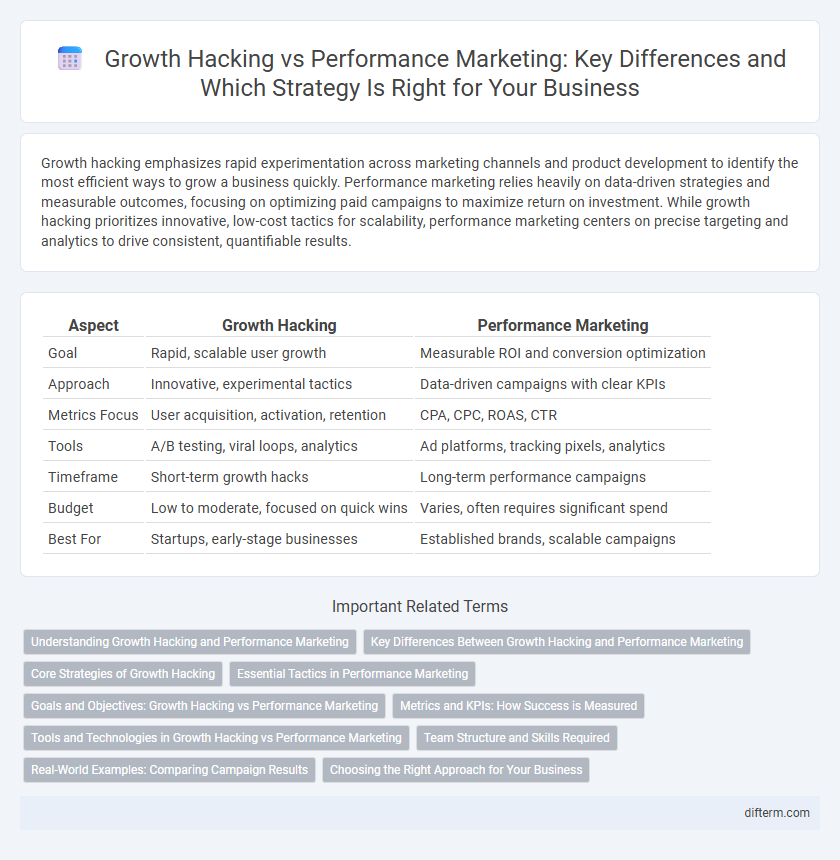Growth hacking emphasizes rapid experimentation across marketing channels and product development to identify the most efficient ways to grow a business quickly. Performance marketing relies heavily on data-driven strategies and measurable outcomes, focusing on optimizing paid campaigns to maximize return on investment. While growth hacking prioritizes innovative, low-cost tactics for scalability, performance marketing centers on precise targeting and analytics to drive consistent, quantifiable results.
Table of Comparison
| Aspect | Growth Hacking | Performance Marketing |
|---|---|---|
| Goal | Rapid, scalable user growth | Measurable ROI and conversion optimization |
| Approach | Innovative, experimental tactics | Data-driven campaigns with clear KPIs |
| Metrics Focus | User acquisition, activation, retention | CPA, CPC, ROAS, CTR |
| Tools | A/B testing, viral loops, analytics | Ad platforms, tracking pixels, analytics |
| Timeframe | Short-term growth hacks | Long-term performance campaigns |
| Budget | Low to moderate, focused on quick wins | Varies, often requires significant spend |
| Best For | Startups, early-stage businesses | Established brands, scalable campaigns |
Understanding Growth Hacking and Performance Marketing
Growth hacking centers on rapid experimentation across marketing channels and product development to identify the most effective, efficient ways to grow a business, often leveraging creative, low-cost strategies. Performance marketing relies on data-driven campaigns with measurable outcomes, optimizing paid advertising efforts through metrics like cost per acquisition (CPA) and return on ad spend (ROAS). Understanding these approaches highlights growth hacking's emphasis on innovation and viral potential, while performance marketing prioritizes precision targeting and accountability.
Key Differences Between Growth Hacking and Performance Marketing
Growth hacking focuses on rapid experimentation across marketing channels and product development to identify the most effective, scalable growth strategies, emphasizing creativity and innovation over traditional metrics. Performance marketing prioritizes measurable outcomes and ROI through data-driven campaigns, relying heavily on paid advertising and precise targeting to drive conversions and sales. The key difference lies in growth hacking's broader, holistic approach to growth through ongoing experimentation versus performance marketing's focus on optimizing specific paid channel results.
Core Strategies of Growth Hacking
Growth hacking centers on rapid experimentation across marketing channels and product development to identify the most effective, scalable growth drivers. Core strategies include leveraging user behavior analytics, viral marketing techniques, and low-cost creative tactics to maximize customer acquisition and retention. By emphasizing agility and data-driven iteration, growth hacking prioritizes innovative solutions to accelerate business growth beyond traditional performance marketing metrics.
Essential Tactics in Performance Marketing
Performance marketing relies heavily on data-driven tactics such as pay-per-click (PPC) advertising, search engine marketing (SEM), and conversion rate optimization (CRO) to maximize ROI. Essential tactics include precise audience targeting, real-time analytics monitoring, and continuous A/B testing to refine ad creatives and landing pages. These strategies enable marketers to allocate budgets efficiently while driving measurable customer acquisition and revenue growth.
Goals and Objectives: Growth Hacking vs Performance Marketing
Growth hacking prioritizes rapid experimentation across marketing channels and product development to identify the most effective ways to grow a business quickly, often focusing on user acquisition and retention through innovative, low-cost strategies. Performance marketing concentrates on measurable results such as cost per acquisition (CPA), return on ad spend (ROAS), and conversion rates, driving scalable campaigns based on data-driven optimization. The key objective in growth hacking is sustainable growth through iterative testing, while performance marketing aims to maximize ROI through targeted and accountable advertising efforts.
Metrics and KPIs: How Success is Measured
Growth hacking emphasizes rapid experimentation across marketing channels and product development to identify the most effective, scalable strategies, focusing on metrics like user acquisition rate, churn rate, and viral coefficient. Performance marketing centers on measurable ROI, tracking KPIs such as cost per acquisition (CPA), click-through rate (CTR), and conversion rate to optimize paid campaigns. Both approaches rely heavily on data analytics but differ in prioritizing agility and innovation versus efficiency and budget optimization.
Tools and Technologies in Growth Hacking vs Performance Marketing
Growth hacking leverages advanced tools like A/B testing platforms, automation software, and analytics dashboards such as Optimizely, Zapier, and Mixpanel to rapidly experiment and optimize user acquisition. Performance marketing relies heavily on technologies including Google Ads, Facebook Ads Manager, and attribution software like Adjust or AppsFlyer to track conversions and maximize ROI through data-driven ad placements. While growth hacking emphasizes agile toolsets for continuous iteration, performance marketing prioritizes robust tracking and attribution technologies for precise budget allocation.
Team Structure and Skills Required
Growth hacking teams emphasize agility, creativity, and cross-functional collaboration, often comprising marketers, developers, and data analysts skilled in rapid experimentation and coding. Performance marketing teams prioritize data-driven decision-making with specialists in PPC, SEO, analytics, and conversion optimization working in clearly defined roles. Both require strong analytical skills, but growth hacking demands a broader technical skill set and adaptability, while performance marketing values deep expertise in campaign management and ROI analysis.
Real-World Examples: Comparing Campaign Results
Growth hacking campaigns often leverage viral content and rapid experimentation, exemplified by Dropbox's referral program that boosted users by 60% in months. Performance marketing focuses on measurable ROI through targeted ads, as seen in Amazon's PPC campaigns that increased sales by 30% annually. Comparing campaign results shows growth hacking excelling in user acquisition speed, while performance marketing delivers consistent, scalable revenue growth.
Choosing the Right Approach for Your Business
Growth hacking emphasizes rapid experimentation across marketing channels and product development to identify the most effective ways to grow a business quickly, often used by startups with limited resources. Performance marketing focuses on measurable results and ROI through paid campaigns, leveraging data analytics to optimize spend and conversions, ideal for businesses with clear sales funnels and marketing budgets. Choosing the right approach depends on your business goals, budget constraints, and the need for scalability versus speed in customer acquisition.
growth hacking vs performance marketing Infographic

 difterm.com
difterm.com